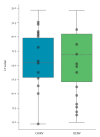Assessment of metagenomic Nanopore and Illumina sequencing for recovering whole genome sequences of chikungunya and dengue viruses directly from clinical samples
- PMID: 30563591
- PMCID: PMC6299504
- DOI: 10.2807/1560-7917.ES.2018.23.50.1800228
Assessment of metagenomic Nanopore and Illumina sequencing for recovering whole genome sequences of chikungunya and dengue viruses directly from clinical samples
Abstract
BackgroundThe recent global emergence and re-emergence of arboviruses has caused significant human disease. Common vectors, symptoms and geographical distribution make differential diagnosis both important and challenging. AimTo investigate the feasibility of metagenomic sequencing for recovering whole genome sequences of chikungunya and dengue viruses from clinical samples.MethodsWe performed metagenomic sequencing using both the Illumina MiSeq and the portable Oxford Nanopore MinION on clinical samples which were real-time reverse transcription-PCR (qRT-PCR) positive for chikungunya (CHIKV) or dengue virus (DENV), two of the most important arboviruses. A total of 26 samples with a range of representative clinical Ct values were included in the study.ResultsDirect metagenomic sequencing of nucleic acid extracts from serum or plasma without viral enrichment allowed for virus identification, subtype determination and elucidated complete or near-complete genomes adequate for phylogenetic analysis. One PCR-positive CHIKV sample was also found to be coinfected with DENV. ConclusionsThis work demonstrates that metagenomic whole genome sequencing is feasible for the majority of CHIKV and DENV PCR-positive patient serum or plasma samples. Additionally, it explores the use of Nanopore metagenomic sequencing for DENV and CHIKV, which can likely be applied to other RNA viruses, highlighting the applicability of this approach to front-line public health and potential portable applications using the MinION.
Keywords: chikungunya; chikungunya virus; dengue; dengue fever; dengue virus; metagenomic; molecular methods; nanopore; surveillance; typing; vector-borne infections; viral infections.
Conflict of interest statement
Figures






References
-
- World Health Organization (WHO). WHO publishes list of top emerging diseases likely to cause major epidemics.Geneva:WHO; 2017 Nov 10. [Accessed 26 Feb 2018]; Available from: http://www.who.int/medicines/ebola-treatment/WHO-list-of-top-emerging-di...
MeSH terms
Substances
LinkOut - more resources
Full Text Sources
Other Literature Sources
Medical
